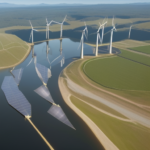The future of energy: Renewable energy sources and energy storage
The future of energy: Renewable energy sources and energy storage
Introduction to Renewable Energy:
Renewable energy sources are becoming increasingly popular due to their sustainability and environmental benefits. These sources include solar, wind, hydroelectric, geothermal, and biomass energy. Unlike fossil fuels, renewable energy sources can be replenished naturally and do not produce harmful emissions that contribute to climate change. As our world faces the challenges of limited fossil fuel reserves and global warming, the transition to renewable energy is crucial in creating a more sustainable future.
Solar Energy:
Solar energy is one of the most abundant renewable energy sources available. It harnesses the power of sunlight through photovoltaic cells to generate electricity. Solar panels can be installed on rooftops or in solar farms to capture sunlight and convert it into usable energy. Advancements in solar technology, such as improved efficiency and lower costs, have made solar energy more accessible to homeowners and businesses. Additionally, solar energy systems can be paired with energy storage solutions like batteries to store excess energy for use during cloudy days or at night.
Wind Energy:
Wind energy is another widely used renewable energy source that utilizes the power of wind to generate electricity. Wind turbines are strategically placed in windy areas, both onshore and offshore, to capture the kinetic energy of the wind and convert it into electricity. Wind power is a clean and sustainable energy source that does not produce greenhouse gas emissions or air pollutants. With ongoing technological advancements, wind energy continues to become more efficient and cost-effective, making it an attractive option for utilities and energy providers.
Hydroelectric Energy:
Hydroelectric power is generated by harnessing the energy of flowing water, typically from rivers or dams. Water turbines are used to convert the kinetic energy of moving water into electricity. Hydroelectric energy is a reliable and renewable energy source that accounts for a significant portion of global electricity generation. It is also a flexible energy source that can be used to meet peak demand and provide grid stability. However, the construction of large dams for hydroelectric projects can have environmental impacts, such as habitat disruption and altered river flow patterns.
Geothermal Energy:
Geothermal energy is derived from the heat within the Earth’s crust. This heat is used to generate electricity through geothermal power plants or to directly heat buildings through geothermal heat pumps. Geothermal energy is a reliable and renewable energy source that produces minimal greenhouse gas emissions. It is particularly well-suited for regions with high geothermal activity, such as volcanic areas. While geothermal energy has the potential to provide a continuous and baseload power supply, the upfront costs of geothermal projects can be significant.
Biomass Energy:
Biomass energy is produced from organic materials such as wood, agricultural residues, and waste products. These materials are burned or converted into biofuels to generate heat, electricity, or transportation fuels. Biomass energy is considered renewable because the organic materials used to produce it can be regrown or replenished. However, the sustainability of biomass energy depends on responsible harvesting practices and the use of waste materials to avoid competing with food production. Biomass energy can be a valuable source of renewable energy, especially in rural areas with access to agricultural or forestry resources.
Energy Storage Solutions:
One of the key challenges of renewable energy sources is their intermittent nature, meaning they are not always available when needed. Energy storage solutions play a crucial role in addressing this challenge by storing excess energy when it is abundant and releasing it when demand is high. Battery storage systems, such as lithium-ion batteries, are commonly used to store energy from solar and wind power systems. Other energy storage technologies include pumped hydro storage, compressed air energy storage, and thermal energy storage. These storage solutions help improve the reliability and stability of renewable energy systems and integrate them into the grid more effectively.


